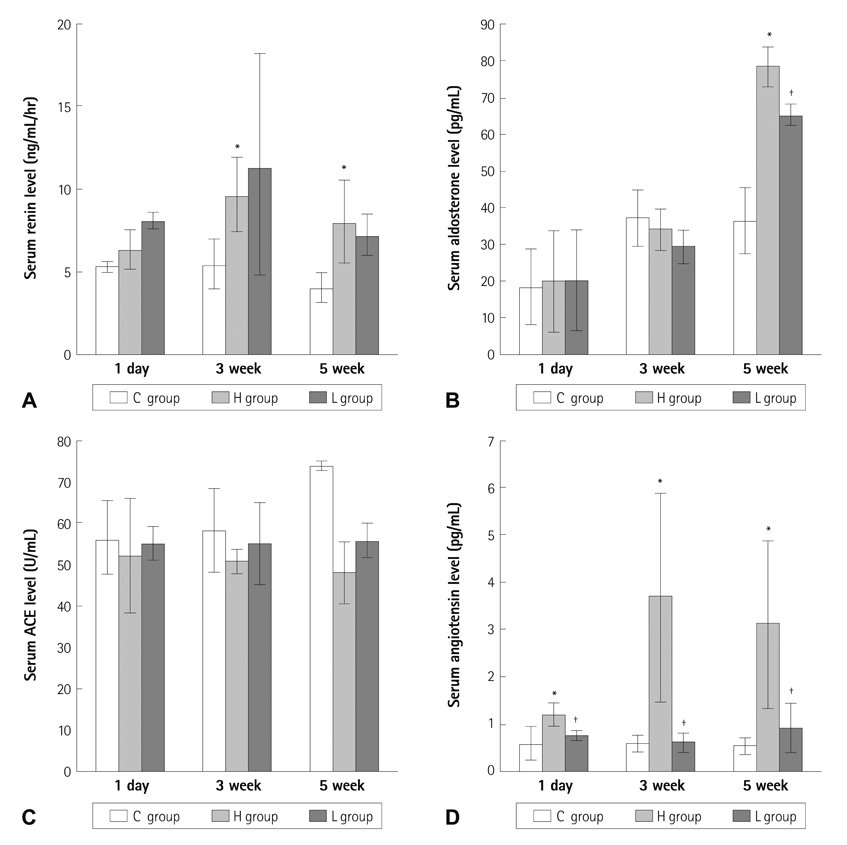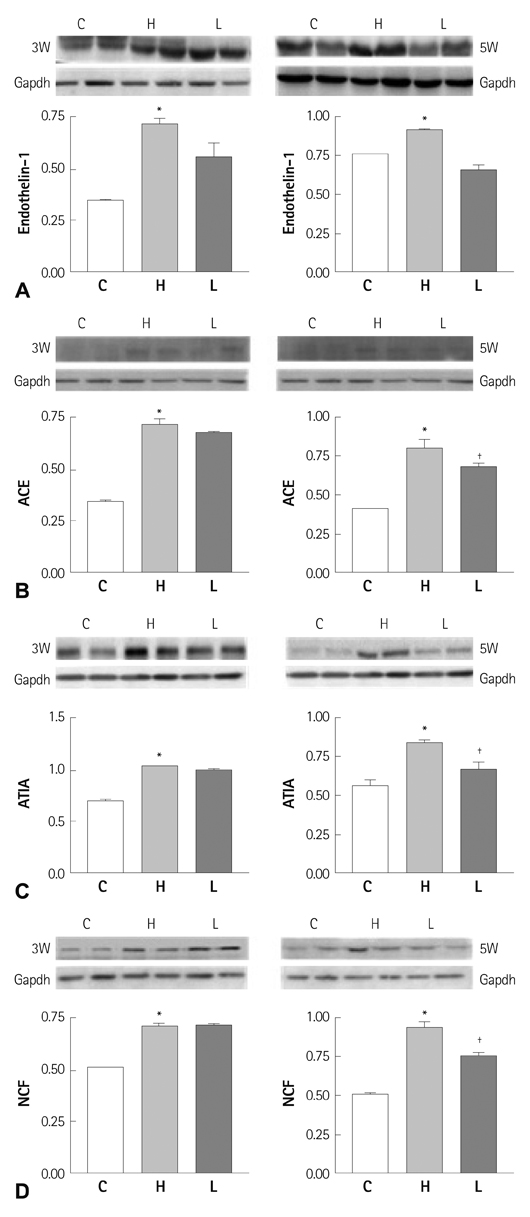Korean Circ J.
2012 Nov;42(11):761-768. 10.4070/kcj.2012.42.11.761.
Changes of Gene Expressions in Spontaneously Hypertensive Rat Model After Losartan Treatment
- Affiliations
-
- 1Department of Pediatrics, Ewha Womans University School of Medicine, Seoul, Korea. hongym@chollian.net
- 2Department of Thoracic and Cardiovascular Surgery, Ewha Womans University School of Medicine, Seoul, Korea.
- 3Department of Pathology, Ewha Womans University School of Medicine, Seoul, Korea.
- KMID: 2224976
- DOI: http://doi.org/10.4070/kcj.2012.42.11.761
Abstract
- BACKGROUND AND OBJECTIVES
The renin angiotensin system seems to play an important role in the development of cardiac and vascular hypertrophy in hypertension. The changes in pathology, and gene expressions of the angiotensin II receptor type 1A (ATIA) and angiotensin converting enzyme (ACE) were investigated in order to explore the effects of losartan in spontaneously hypertensive rat (SHR) models.
MATERIALS AND METHODS
Twelve week-old male Wistar rats were grouped as follows: control (C) group, hypertension (H) group, and losartan (L) group in which SHR was treated with losartan (10 mg/kg/day). Western blot and reverse transcription-polymerase chain reaction analysis regarding seven genes such as endothelin-1, ACE, ATIA, neutrophil cytosolic factor, brain natriuretic peptide, troponin I, endothelial nitric oxide synthase were performed.
RESULTS
Systolic blood pressure was significantly decreased in the L group compared with the H group in weeks 3 and 5. ACE and ATIA proteins in the L group were lower than H group in week 5.
CONCLUSION
Losartan reduced blood pressure, cardiac hypertrophy and protein expressions of ACE and ATIA. Changes of protein expressions were more sensitive than changes in pathology. Further study is needed for the differing doses of losartan in SHR models.
MeSH Terms
-
Blood Pressure
Blotting, Western
Cardiomegaly
Cytosol
Endothelin-1
Gene Expression
Humans
Hypertension
Hypertrophy
Losartan
Male
Natriuretic Peptide, Brain
Neutrophils
Nitric Oxide Synthase Type III
Peptidyl-Dipeptidase A
Proteins
Rats, Inbred SHR
Rats, Wistar
Receptors, Angiotensin
Renin-Angiotensin System
Troponin I
Endothelin-1
Losartan
Natriuretic Peptide, Brain
Nitric Oxide Synthase Type III
Peptidyl-Dipeptidase A
Proteins
Receptors, Angiotensin
Troponin I
Figure
Cited by 1 articles
-
Effect of Small Hairpin RNA Molecules Targeting Angiotensin-converting Enzyme Gene in Spontaneously Hypertensive Rats
Young Mi Hong, Hye Ryon Lee, Kwan Chang Kim
J Korean Soc Hypertens. 2012;18(3):105-116. doi: 10.5646/jksh.2012.18.3.105.
Reference
-
1. Li JJ, Fang CH, Hui RT. Is hypertension an inflammatory disease? Med Hypotheses. 2005. 64:236–240.2. Schillaci G, Pirro M, Gemelli F, et al. Increased C-reactive protein concentrations in never-treated hypertension: the role of systolic and pulse pressures. J Hypertens. 2003. 21:1841–1846.3. Efimova O, Szankasi P, Kelley TW. Ncf1 (p47phox) is essential for direct regulatory T cell mediated suppression of CD4+ effector T cells. PLoS One. 2011. 6:e16013.4. Galzerano D, Capogrosso C, Di Michele S, et al. New standards in hypertension and cardiovascular risk management: focus on telmisartan. Vasc Health Risk Manag. 2010. 6:113–133.5. Freeman EJ, Ferrario CM, Tallant EA. Angiotensins differentially activate phospholipase D in vascular smooth muscle cells from spontaneously hypertensive and Wistar-Kyoto rats. Am J Hypertens. 1995. 8:1105–1111.6. López B, González A, Varo N, Laviades C, Querejeta R, Díez J. Biochemical assessment of myocardial fibrosis in hypertensive heart disease. Hypertension. 2001. 38:1222–1226.7. Rosendorff C. The renin-angiotensin system and vascular hypertrophy. J Am Coll Cardiol. 1996. 28:803–812.8. Ruiz-Gayo M, Somoza B, Bravo R, Fernández-Alfonso MS, González C. Chronic losartan treatment decreases angiotensin II-mediated facilitation of noradrenaline release in the caudal artery of spontaneously hypertensive rats. Life Sci. 2000. 67:3153–3162.9. An SJ, Boyd R, Wang Y, Qiu X, Wang HD. Endothelin-1 expression in vascular adventitial fibroblasts. Am J Physiol Heart Circ Physiol. 2006. 290:H700–H708.10. Yokoyama H, Averill DB, Brosnihan KB, Smith RD, Schiffrin EL, Ferrario CM. Role of blood pressure reduction in prevention of cardiac and vascular hypertrophy. Am J Hypertens. 2005. 18:922–929.11. Okamoto K, Aoki K. Development of a strain of spontaneously hypertensive rats. Jpn Circ J. 1963. 27:282–293.12. Koprdova R, Cebova M, Kristek F. Long-term effect of losartan administration on blood pressure, heart and structure of coronary artery of young spontaneously hypertensive rats. Physiol Res. 2009. 58:327–335.13. Rizzoni D, Porteri E, Piccoli A, et al. Effects of losartan and enalapril on small artery structure in hypertensive rats. Hypertension. 1998. 32:305–310.14. Zhao LL, Chen HJ, Chen JZ, Yu M, Ni YL, Zhang WF. Losartan reduced connexin43 expression in left ventricular myocardium of spontaneously hypertensive rats. J Zhejiang Univ Sci B. 2008. 9:448–454.15. Choi SM, Seo MJ, Kang KK, Kim JH, Ahn BO, Yoo M. Beneficial effects of the combination of amlodipine and losartan for lowering blood pressure in spontaneously hypertensive rats. Arch Pharm Res. 2009. 32:353–358.16. Dai Q, Xu M, Yao M, Sun B. Angiotensin AT1 receptor antagonists exert anti-inflammatory effects in spontaneously hypertensive rats. Br J Pharmacol. 2007. 152:1042–1048.17. Fortuño MA, Ravassa S, Etayo JC, Díez J. Overexpression of Bax protein and enhanced apoptosis in the left ventricle of spontaneously hypertensive rats: effects of AT1 blockade with losartan. Hypertension. 1998. 32:280–286.18. Diep QN, El Mabrouk M, Yue P, Schiffrin EL. Effect of AT(1) receptor blockade on cardiac apoptosis in angiotensin II-induced hypertension. Am J Physiol Heart Circ Physiol. 2002. 282:H1635–H1641.19. Slaninka-Miceska M, Bogdanska J, Korneti P, Kostova E, Jovanoska E, Petrov S. Effect of angiotensin II type 1 (AT1) receptor antagonist on the endothelial dysfunction in spontaneously hypertensive rats in correlation with the nitric oxide system. Bratisl Lek Listy. 2003. 104:342–346.20. Koo HS, Kim KC, Hong YM. Gene expressions of nitric oxide synthase and matrix metalloproteinase-2 in monocrotaline-induced pulmonary hypertension in rats after bosentan treatment. Korean Circ J. 2011. 41:83–90.21. Mondry A, Swynghedauw B. Biological adaptation of the myocardium to chronic mechanical overload. Molecular determinants of the autonomic nervous system. Eur Heart J. 1995. 16:Suppl I. 64–73.22. Ferrario CM. Addressing the theoretical and clinical advantages of combination therapy with inhibitors of the renin-angiotensin-aldosterone system: antihypertensive effects and benefits beyond BP control. Life Sci. 2010. 86:289–299.23. Garg UC, Hassid A. Nitric oxide-generating vasodilators and 8-bromocyclic guanosine monophosphate inhibit mitogenesis and proliferation of cultured rat vascular smooth muscle cells. J Clin Invest. 1989. 83:1774–1777.24. Tea BS, Der Sarkissian S, Touyz RM, Hamet P, deBlois D. Proapoptotic and growth-inhibitory role of angiotensin II type 2 receptor in vascular smooth muscle cells of spontaneously hypertensive rats in vivo. Hypertension. 2000. 35:1069–1073.25. Pellman J, Lyon RC, Sheikh F. Extracellular matrix remodeling in atrial fibrosis: mechanisms and implications in atrial fibrillation. J Mol Cell Cardiol. 2010. 48:461–467.
- Full Text Links
- Actions
-
Cited
- CITED
-
- Close
- Share
- Similar articles
-
- Microarray Analysis in Spontaneously Hypertensive Rat Heart after Losartan Treatment
- Changes of Bax, Bcl-2, CCR-2, MCP-1, and TGF-β1 genes in the left ventricle of spontaneously hypertensive rat after losartan treatment
- Effects of Centrally Administered Losartan on Deoxycorticosterone-salt Hypertension Rats
- Losartan Reduces Remodeling and Apoptosis in an Adriamycin-Induced Cardiomyopathy Rat Model
- The Studies of Contractile and Relaxing Responses of Abdominal Aorta and Effects of Angiotensin II Blocker(Losartan) in Spontaneously Hypertensive Rats Combined with Renovascular Hypertension





